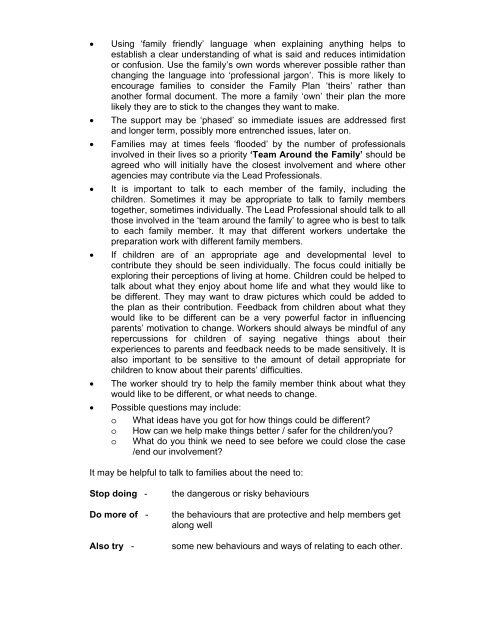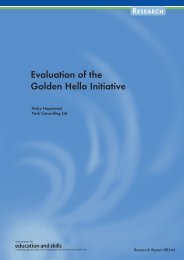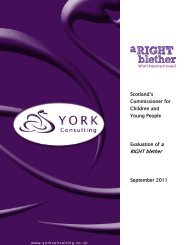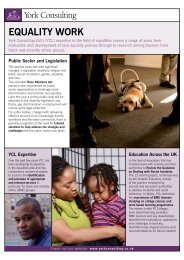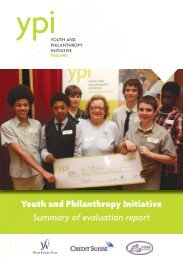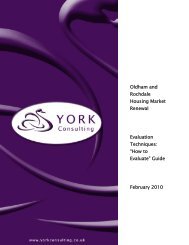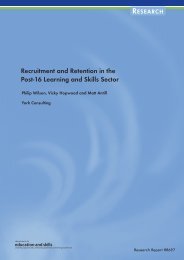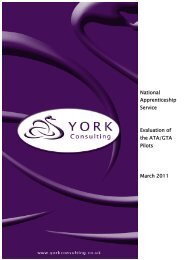The use of whole family assessment to identify the needs of families ...
The use of whole family assessment to identify the needs of families ...
The use of whole family assessment to identify the needs of families ...
Create successful ePaper yourself
Turn your PDF publications into a flip-book with our unique Google optimized e-Paper software.
Using ‘<strong>family</strong> friendly’ language when explaining anything helps <strong>to</strong>establish a clear understanding <strong>of</strong> what is said and reduces intimidationor confusion. Use <strong>the</strong> <strong>family</strong>’s own words wherever possible ra<strong>the</strong>r thanchanging <strong>the</strong> language in<strong>to</strong> ‘pr<strong>of</strong>essional jargon’. This is more likely <strong>to</strong>encourage <strong>families</strong> <strong>to</strong> consider <strong>the</strong> Family Plan ‘<strong>the</strong>irs’ ra<strong>the</strong>r thanano<strong>the</strong>r formal document. <strong>The</strong> more a <strong>family</strong> ‘own’ <strong>the</strong>ir plan <strong>the</strong> morelikely <strong>the</strong>y are <strong>to</strong> stick <strong>to</strong> <strong>the</strong> changes <strong>the</strong>y want <strong>to</strong> make.<strong>The</strong> support may be ‘phased’ so immediate issues are addressed firstand longer term, possibly more entrenched issues, later on.Families may at times feels ‘flooded’ by <strong>the</strong> number <strong>of</strong> pr<strong>of</strong>essionalsinvolved in <strong>the</strong>ir lives so a priority ‘Team Around <strong>the</strong> Family’ should beagreed who will initially have <strong>the</strong> closest involvement and where o<strong>the</strong>ragencies may contribute via <strong>the</strong> Lead Pr<strong>of</strong>essionals.It is important <strong>to</strong> talk <strong>to</strong> each member <strong>of</strong> <strong>the</strong> <strong>family</strong>, including <strong>the</strong>children. Sometimes it may be appropriate <strong>to</strong> talk <strong>to</strong> <strong>family</strong> members<strong>to</strong>ge<strong>the</strong>r, sometimes individually. <strong>The</strong> Lead Pr<strong>of</strong>essional should talk <strong>to</strong> allthose involved in <strong>the</strong> ‘team around <strong>the</strong> <strong>family</strong>’ <strong>to</strong> agree who is best <strong>to</strong> talk<strong>to</strong> each <strong>family</strong> member. It may that different workers undertake <strong>the</strong>preparation work with different <strong>family</strong> members.If children are <strong>of</strong> an appropriate age and developmental level <strong>to</strong>contribute <strong>the</strong>y should be seen individually. <strong>The</strong> focus could initially beexploring <strong>the</strong>ir perceptions <strong>of</strong> living at home. Children could be helped <strong>to</strong>talk about what <strong>the</strong>y enjoy about home life and what <strong>the</strong>y would like <strong>to</strong>be different. <strong>The</strong>y may want <strong>to</strong> draw pictures which could be added <strong>to</strong><strong>the</strong> plan as <strong>the</strong>ir contribution. Feedback from children about what <strong>the</strong>ywould like <strong>to</strong> be different can be a very powerful fac<strong>to</strong>r in influencingparents’ motivation <strong>to</strong> change. Workers should always be mindful <strong>of</strong> anyrepercussions for children <strong>of</strong> saying negative things about <strong>the</strong>irexperiences <strong>to</strong> parents and feedback <strong>needs</strong> <strong>to</strong> be made sensitively. It isalso important <strong>to</strong> be sensitive <strong>to</strong> <strong>the</strong> amount <strong>of</strong> detail appropriate forchildren <strong>to</strong> know about <strong>the</strong>ir parents’ difficulties.<strong>The</strong> worker should try <strong>to</strong> help <strong>the</strong> <strong>family</strong> member think about what <strong>the</strong>ywould like <strong>to</strong> be different, or what <strong>needs</strong> <strong>to</strong> change.Possible questions may include:o What ideas have you got for how things could be different?o How can we help make things better / safer for <strong>the</strong> children/you?o What do you think we need <strong>to</strong> see before we could close <strong>the</strong> case/end our involvement?It may be helpful <strong>to</strong> talk <strong>to</strong> <strong>families</strong> about <strong>the</strong> need <strong>to</strong>:S<strong>to</strong>p doing -Do more <strong>of</strong> -Also try -<strong>the</strong> dangerous or risky behaviours<strong>the</strong> behaviours that are protective and help members getalong wellsome new behaviours and ways <strong>of</strong> relating <strong>to</strong> each o<strong>the</strong>r.


